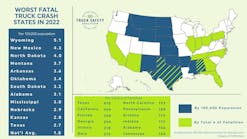The U.S. Department of Transportation's Pipeline and Hazardous Materials Safety Administration (PHMSA) recently proposed a new rule aimed at saving nearly $100 million annually for businesses and consumers.
The rule seeks to modernize and simplify hazardous materials (hazmat) transportation regulations, enhancing safety standards across road, rail, and water modes of transport, particularly for fuels like gasoline. Key aspects include easing hazard communication requirements for truck drivers, expediting tank car design reviews for rail safety, and modernizing standards for agricultural equipment. These changes are designed to reduce regulatory burdens and improve supply chain efficiency, PHMSA reported.
“The proposal we’re announcing today streamlines requirements while maintaining safety measures, helping to reduce costs for businesses and consumers and make it easier for drivers to do their job,” U.S. Secretary of Transportation Pete Buttigieg said in a news release.
PHMSA, in collaboration with the Federal Motor Carrier Safety Administration, is proposing several revisions to the Hazardous Materials Regulations (HMR) concerning the transportation of hazardous materials by highway (i.e., motor vehicles). These proposed changes are expected to improve the safe transportation of hazardous materials on highways, while also offering clearer guidelines and increased regulatory flexibility.
Along with other updates to the HMR, PHMSA is suggesting dozens of amendments, with the following as highlights, according to a National Tank Truck Carriers release:
- In part 107, subpart F, revise the registration requirements to allow for electronic submission procedures
- In part 107 subpart F, create cargo tank facility modification, suspension, and termination procedures; reconsideration of modification, suspension, and termination procedures; and appeal of modification, suspension, and termination procedures
- In the § 172.336(c) table, add a sixth row to specify that a cargo tank may display the UN ID number of the petroleum distillate fuel with the lowest flash point transported in different trips on the previous or current business day, except for gasoline and alcohol fuel blends with more than 10% ethanol
- In § 177.816(c) and (d), clarify the use of tank vehicle endorsement or hazardous materials endorsement training to fulfill the hazardous materials training requirements of §§ 172.704 and 177.816
- In § 178.320, revise definitions for cargo tank, cargo tank motor vehicle, and minimum thickness and add definitions for: cargo tank motor vehicle certification date, component, flexible connector, lading retention system, lining, name plate, original test date, sacrificial device, shear section, and specification plate
- In a new § 180.407(a)(7), specify that all equipment and instruments used to test cargo tanks must be calibrated, with appropriate documentation, in accordance with the manufacturer’s instructions
- In a new § 180.407(a)(8), allow for the use of video cameras or video optics equipment for any inspection or test
- In a new § 180.407(a)(10), require that the Registered Inspector consult with the owner or motor carrier, as appropriate, to determine if materials corrosive or reactive to the cargo tank or its components were transported in the cargo tank motor vehicle since the last test or inspection, and ensure that the proper tests and inspections, along with suitable safeguards, are used
The proposal is open for public comment for 90 days following its publication in the Federal Register.
“It is important to note that many of these proposed changes, specifically regarding § 172 and § 180, result from NTTC policy letters and/or comments and questions raised during FMCSA/NTTC Cargo Tank Workshops,” NTTC stated.









